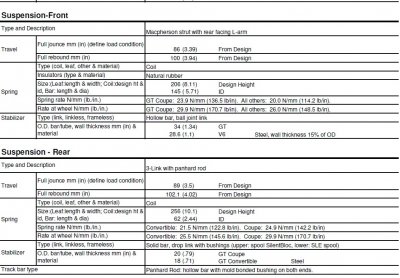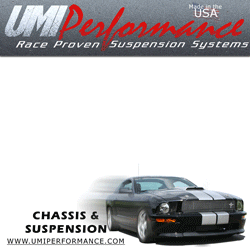Yep, and (per the previous discussion we had) the S197 is apparently quite a bit better (if Sam Strano's right) about this than a lot of McStrut platforms, hence the need to go with much higher front rates in order to maximize grip is significantly reduced. Between that and the front bar, it's sounding like the only real reason for significantly stiffening the ride is high speed controllability under heavy braking.
Maybe the S197 is better than others, maybe it's not, but I've had a dozen or so sets of front tires wiped out on the outside edge, despite the higher-than-stock spring AND bar rates, and a static -2.7* camber setting. I've essentially come to the conclusion that I just need to dial in more static negative to keep the tires alive, OR increase the spring rates to minimize the camber change. At this point, I'm leaning towards a bit of both. I'm considering going to something on the order of 500-550lb front springs, and moving to -3.0* camber and see how that does. The goal is to get a single set of tires to cord essentially evenly in an endurance race situation. Currently, I can get between 3-4 hours out of the fronts before I start grinding the outside edges off completely. I want to extend that to around 5 hours or so.
I was thinking about this a bit. Seems to me that the wheel rate at the rear isn't a simple constant like it would be with an independent suspension, but is instead a variable, and (thanks to the fact that the springs are located somewhat inboard) the wheel rate at one end is not just due to the spring at that end, but due in part to the spring at the other end, as well. Which is to say, if you keep one end of the rear suspension anchored and move the other end vertically, the resulting wheel rate is a function of both springs.
You are correct, however you have to remember that "one end anchored" isn't a realistic situation. The car is going to pivot around the rear roll center, and any compression on one side is going to have some corresponding rebound on the other. Granted, even THIS is simplified, since in the real world, most of the time the rear will also be either lifting or squatting due to either trail-braking or accelerating through.
How does AS% and AD% affect the wheel rates in steady state cornering? I can obviously see how they would affect it during braking and acceleration.
In short, they don't affect the wheel rate in steady-state at all. They DO affect the rate dramatically, however, in a real-world setting where you have something other than a billiard-table-smooth track to drive on. The instantaneous nature of the AS% and AD% can and will exacerbate a transient (high-speed) surface imperfection, like an expansion joint, or pothole. To keep from popping the tires clean off the ground, you MAY need to adjust your spring rates a touch. The other thing to chat about here, is the "steady state cornering" concept. Outside of a skidpad or for use when doing theoretical modeling (to simplify and isolate causes and effects), there is NO such thing on a road course. At least not for any appreciable duration of time, anyway. On a "traditional 90* corner," I would probably trail-brake in, then rapidly transition to the gas pedal. At this point I *COULD* steady-state through the corner, then roll into the gas after apex. Or, what I actually do, is immediately start pushing the gas, hunting/feeling the grip limit the whole time. Since I normally take some variation on a late-apex line, I'm never describing a smooth (constant radius) curve anywhere in the corner. The initial turn-in is sharp (tight radius), then right around apex (+/- rotational attitude and momentum) the radius begins to increase, and with it, the effective Vmax that can be carried. So, the time not spent either decelerating or accelerating is very, very minimal, to the point of not being worth discussing. Even on a carousel (and there are only five in my entire region!), I'm pretty aggressively hunting for the traction limits, so again, little steady-state throttle, which is a requirement for steady-state cornering. Just food for thought.
Okay, well, in my case, the rubber is going to be more or less a constant: 285/35-19 street tires. I'm not in this for competition, I'm in it for fun, so getting minimum lap times isn't what this is about for me.
Understood. Rubber choice really doesn't matter per se, but the concept that you need to tune TO that rubber is still an essential one. If you swapped over to Hoosiers, you would need to completely change your setup (and driving style) to take advantage of what they offer. Switching back to the street rubber would again require a change. The setup on the car is there to promote maximum utility of the traction patch. Period. Doing anything else is simply selling yourself short.
From what I've seen of pictures of these cars in stock form under heavy braking, it looks to me like the bulk of the motion under heavy braking is actually in the rear due to the suspension "jacking up" back there. How will changing AD% affect the ride on bumpier surfaces? Will it result in more "skipping" over irregularities under heavy braking or something?
Take a good look again at some side-view shots of cars under heavy braking. There will be a pivot point in side view around which the car will apparently rotate... Weight transfer is simply that, transfer. None is created or lost, therefore the net weight on the four corners must remain essentially equal (+/- inertial effects). Does the rear "jack up" more than the front dives? Quite possibly, and that will be a function of where that side-view "roll center" is located, as well as the distances from that "roll center" to the axle centerlines, analagous to motion ratio. And AS% and AD% will certainly affect how the suspension handles transient impacts. Remember that the front suspension has AS% and AD% as well! Having the front control arms non-parallel to the ground in side view will affect how they react to weight transfer, as well as handle surface irregularities.
And since mine is a DD, there's going to be a limit as to how hard I can make the spring rates without compromising the ride. I have driven a car with KW v3 coilovers and the ride was surprisingly good (equal to or better than stock over most bumps that did not exceed the suspension travel capability of the car with the given springs), so damper quality seems to be capable of making up for a lot. But there's a caveat here: the KW v3 springs are apparently progressive, and I don't know what rates they have at/near ride height compression.
And when you factor those in, I expect the "win" goes primarily towards the "soft springs/heavy bars" school, right?
To a point, you are correct. Proper damper curves that match the springs on the car will go a LLLOONNNGG way towards maximizing the "ride quality" of the entire suspension package, as you noted with the KW comment. My comment about "peeing blood" that Barbaro took and ran with was more about running a pure track setup on the street with no changes. If I dial my ASTs all the way soft, the ride is quite reasonable, however, that's not what I use the car for. I think it's a given that with equal damper effectiveness, a stiffer spring will generate a harder ride. Soft springs and cheap dampers could easily ride "worse" than hard springs with proper damper curves, though. So no, it's not as easy as saying "soft springs mean a better ride."
As for whether or how much the coilovers will limit your rebound travel at a given ride height, that might be a question best asked directly to the manufacturers, or their better-educated sales staff, like Terry or Sam.
I was very impressed with how well, in the video you posted, your coilover setup handled the irregularities of that road course compared with the BMR springs and Tokicos. The car just seemed completely stable with the coilovers. Between that and my experience with the KW v3 coilovers, they are a very tempting route for me. But given my hard requirements, I don't (yet) see how they can be made to work for me. Help!
That level of control, where the car simply soaks up the irregularities and handles dynamic loads with aplomb, is what you get for your hard-earned shekles when you go with a good damper. I'm not saying that a Koni yellow won't give you the bulk of that, however, the AST-level damper simply gives smoother control than even the Koni.
If I wind up changing springs, I'll jack the adjusters all the way up on mine and measure from wheel lip to spindle center and see exactly what the maximum ride-height would be. Obviously, that will change if you use something other than GEN1 AST4100's, so on second though, I think I'll blow that off.
I'm still betting that you can accommodate all the requirements you have with a good set of coil-overs. If nothing else, you'll have access to spring rates in 25lb increments from slinky to rigid, and at a MUCH more affordable price than having OE-fitment pieces custom-wound. What you might be able to do is take a measurement from the bottom of the stock bearing plate to the top strut bolt hole, and use that as a "loaded metric." Then jack the front up (both sides!!) and re-do the measurement to see what maximum rebound travel would be. Then take those numbers to AST/KW/MCS/Sachs/Penske/Ohlins/etc. and see how their measurements would compare. With a coilover, you could consider their max extension to be the equivalent to your full droop, and then do the math from there to deterimine where you would be in the total stroke of the piston based on your individual corner-weights. If you haven't scaled the car, use something around 950-1100 for the fronts. Assume that the springs are set up to just touch the bearing plate at full droop (zero preload), and then divide the 950-1100 by the spring rate to get static compression of the strut. IE, assuming 1000lbs, and 250lb springs, that will compress the strut 4" by simply putting it on the ground. If you have a 7" total stroke, that means you have 3" of bump travel, and 4" of rebound travel before running out of stroke. It would be better if you had actual corner-weights, of your particular car, to work with, as it will be more accurate, however, those numbers will get you in the ballpark.
Does anybody know the total stroke available on a stock strut? That might help in the comparison. In the end, though, I don't think a 3/4" to 1" total reduction in travel is going to mean much, particularly if you maintain stock or near-stock amounts of compression stroke. If you reduce your rebound stroke from (example only!) 4" to 3", you'll only run out of room if the pothole you drive into is MORE than 3" deep... And you shouldn't be driving in those anyway, you might kill the fish living in it!
How much of the "driveway scrape" is due to the pure geometry of the situation, and how much is due to suspension motion on very soft springs? If you creep onto the driveway apron, how much actual clearance are we looking at?







